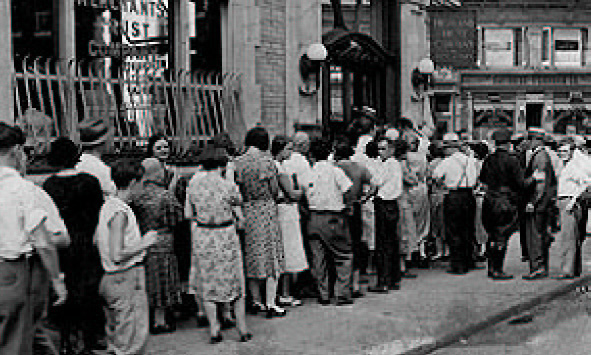Background
Stock Market Crash of 1929
From the early 1920s to the end of 1928 economic activity had doubled,
even tripled, yearly outstripping all but the rosiest predictions. Combinations,
investment trusts, stock and bond issues and land syndicates proliferated.
As early as March of 1929, there were signs the economy was headed for
trouble. Industrial production and real estate sales were declining. Earnings
on stocks were significantly less than interest on brokers' loans. The
shock came on Thursday, October 24, 1929 when a wave of sell orders hit
the New York Stock Exchange. Stock prices plunged as panicky speculators
dumped millions of shares, many of which were bought on margin. The impact
on the country was not immediate except in the real estate market where
prices declined as speculators attempted to liquidate their holdings to
pay for their loans on stock and / or real estate.
Weak Banks Fail
As defaults on the loans increased, the banks found the collateral that
backed the loans had less value than the outstanding loan balance. Caught
in the squeeze, banks were forced to dip into cash reserves. Many banks
like the 1st National Bank of Chattanooga also sold real estate participation
certificates that that paid interest. As real estate lost value the bank
had to use additional reserves to pay the interest on the certificates.
As cash reserves decreased, rumors begin to circulate that the bank did
not have enough money to cover the deposits of there customers. As rumors
spread more and more customers would demand their money, creating a run
on the bank. The bank either failed or merged with another stronger bank.
Bank Failures fail across the U.S.
In early February 1933 the Louisiana governor closed the banks in the
state and declared a "banking holiday" to stop heavy withdraws that were
about to bankrupt may state banks. Before the end of February, Michigan,
Indiana, Maryland Arkansas, Kentucky, Ohio California, Pennsylvania, Minnesota,
Indiana and Oklahoma governors had either declared a "banking holiday"
or frozen withdrawals. By March 1st 5,504 banks in 31 states were on holiday.
On March 4th New York banks, the largest in the country, declared a "banking
holiday". This was the last day of President Hoover presidency. He said,
"We are at the end of our string. There is nothing more we can do."
Roosevelt suspends gold payments, declares national "bank holiday
On the second day in office, Sunday March 5, 1933, President Roosevelt
proclaimed a national "banking holiday", suspended payments in gold and
silver, authorized clearing house certificates to provide a medium of
exchange during the banking holiday and ordered bankers to turn in names
of gold hoarders for prosecution.
Congress enacted legislation supporting Roosevelt's proclamation by
Friday March 9th. The legislation banned gold ownership by US citizens,
and expanded the money supply by printing and issuing Federal Reserve
Bank Notes. It also provided loans from the Federal Reserve to member
banks that had been audited and certified as sound.
|
